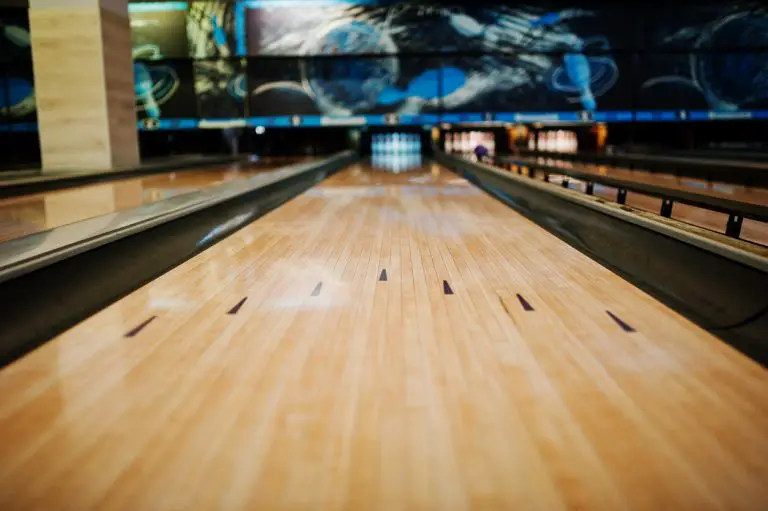What Are Bumpers For In Bowling Lanes? (We’ve Got The Answer)
What are bumpers in bowling lanes? People who go to bowling alleys sometimes ask for bumpers before starting the game. But if you are a beginner in this sport, you may ask what bumpers are and their purpose.
Bumpers are metal or rubber railings that block a bowling lane’s gutters. They prevent gutter balls, thus keeping the ball on the lane. Bowling balls ricochet when they hit the bumpers, so players have a higher chance of knocking down the bowling pins.
This article will help you understand bowling lane bumpers and how they can make a difference in your game.
What Are Bumpers In Bowling Lanes?
Have you ever tried bowling to find out that you cannot keep the ball in the lane? Imagine trying to deliver the bowling balls multiple times, only for them to end up in the gutter. No matter how hard you try, you cannot hit the bowling pins at the end of the lane.
It is a common scenario for beginners in bowling. For this reason, Phil Kinzer invented bowling lane bumpers in 1982. But what exactly are bowling lane bumpers, and how do they work?
Bumpers In Bowling Lanes
Bowling lane bumpers resemble metal railings. They fence off a bowling lane’s gutters to prevent the bowling balls thrown by players will remain on the lane. When bowling lane bumpers are on, players have a higher chance of knocking over bowling pins.
With bowling lane bumpers, your bowling ball will bounce back in the middle of the lane even if it swerves into the gutter multiple time.
Phil Kinzer, the Dallas-based Jupiter Lanes Bowling Center owner, invented bumpers. Kinzer noticed that his son kept having gutter balls, preventing him from enjoying the game. He wanted to help beginner bowling players to develop their confidence by assisting them in preventing gutter balls. For this reason, he blocked the bowling lane gutters in his alley with cardboard tubes.
How Bumpers Became A Thing In Bowling
Bumpers became a popular part of many bowling alleys. After some time, inflatable tubes replaced the cardboard bumpers. However, bowling alley owners discovered that inflating the tubes can be time-consuming. As a result, Kinzer developed a more durable and easier-to-maintain bumper.
Today, bowling alleys are still using the bumpers developed by Kinzer. These bumpers come in the form of retractable metal railings placed within bowling lane gutters. Today, bowling alleys use either manual or automatic bowling lane bumpers.
How To Turn On Bumpers In Bowling
Bumpers are not a standard part of bowling lanes. So, they will not be present in your lane unless you activate them. They are also more common in modern bowling alleys, so you may not find them if you play in older bowling alleys.
You can activate bumpers in the lane by asking the bowling alley’s staff to turn them on before you start your game. If the bowling alley you are in has manual bumpers, the staff will use a long metal rod to pull them up and lock them.
It is essential to note that manual bumpers stay activated throughout your game. You cannot ask the staff only to activate them whenever it is your turn to deliver the bowling ball.
In other bowling alleys, you will need to ask the staff to activate the bumpers in bowling lanes for you, even if they are automatic bumpers.
On the other hand, some bowling alleys have bumpers that you can activate through the scoring console. You can choose when the bumpers activate and retract in bowling alleys with such bumpers.
If you want to use the bumpers, specify them in your player profile when setting it up in the scoring console. This way, the bumpers will only activate when it is your turn and retract if the other players you are with do not need them. (source)
Who Needs Bumpers In Bowling Lanes?
While Kinzer developed bumpers for children and people who find it hard to keep the bowling ball on the lane, anyone can use them for the game. Some players who commonly use bumpers are children, the elderly, and people with disabilities, preventing them from accurately aiming at the bowling pins.
Bumpers allow them to enjoy bowling by increasing their chances of hitting the pins even if the ball they deliver does not stay in the middle of the lane.
Even regular adults who are still learning to play bowling can use bumpers. This way, they can prevent gutter balls until they develop the skills to deliver bowling balls accurately.
Do Bowling Tournaments Allow The Use Of Bumpers?
Formal bowling tournaments allow bumpers in bowling lanes if the players are children. On the other hand, bowling leagues usually ban the use of bumpers for adult tournaments. (source)
One reason bowling leagues allow children’s tournaments to use bumpers is that young players are still developing their skills.
There is a higher chance for gutter balls than in adult tournaments where players are already professionals. By allowing bumpers, young players will have a game that matches their skills.
On the other hand, allowing adults to use bumpers during formal tournaments may make the game too easy for them. The players who join adult bowling tournaments are also professionals, so they no longer need bumpers to prevent gutter balls.
Meanwhile, the skills of young players are still not as developed as that of an adult. For this reason, they need the bumpers in bowling lanes during competitions. (source)
Final Thoughts
Bumpers in bowling lanes are metal railings that cover the gutters during games. They prevent bowling balls from getting into the gutter, increasing a player’s chance of getting a score.
In addition, anyone can use bumpers when bowling. While these tools are often associated with children, the elderly, and the disabled, regular adults can also use them when practicing their skills in bowling. Bumpers can guide you until you develop accuracy in throwing bowling balls.
- United States Patent. Bowling Bumper System Method Of Use And Installation. https://patentimages.storage.googleapis.com/67/d9/64/537726fbe8fab5/US8083603.pdf. Accessed October 18, 2022.
- Special Olympics Kentucky. Bowling Manual Rules, Regulations & Training Information. https://soky.org/update/wp-content/uploads/2016/07/Bowling_Manual.pdf. Accessed October 18, 2022.
- A.J. Forrest and Lisa Iannucci. Bowling For Dummies. Canada: Wiley Publishing, 2010. http://ndl.ethernet.edu.et/bitstream/123456789/24818/1/A.J_%20Forrest_2010.pdf. Accessed October 18, 2022.





